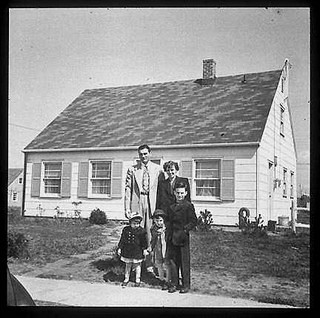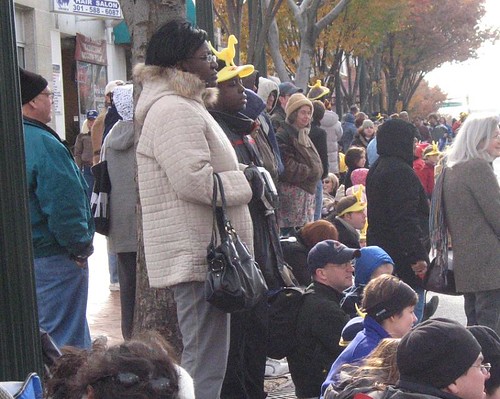The future of mixed use development/urbanization: Part 1, Housing
The first session on Saturday at the Makeover Montgomery conference was about financing mixed use development. All three presentations were quite good.
Shyam Kannan of Robert Charles Leser & Co., LLC spoke ostensibly about "Paying it Forward - Leveraging Market Forces to Fund Smart Growth," but I thought of his presentation more about the demographic and preference issues shaping the future of the U.S. housing market and how this impacts cities and suburbs.
Robert Rosenfeld of JBG Rosenfeld Retail, a company very active in the DC market, covered "The Challenge of Financing Infill Development." Basically from him we learned that except for the best locations, most suburban mixed use will be one floor of retail with 4 stories of housing above, in so called "stick built" construction.
Daniel K. Slone of McGuireWoods LLP, gave just a little bit of what clearly was a presentation maybe 4-5 times longer than he had time to present on "Planned Densification: Issues of Planning, Building and Harvesting Value of Anticipated Densities."
This post will focus on demographic change and the housing market and is in part a response to Shyam Kannan's presentation.
I have heard Rollin Stanley, the planning director of Montgomery County, speak before and from his presentations I have learned a lot about demographic changes--mostly that younger people are less interested in living in large single family houses in disconnected subdivisions far from work and activity centers--in the context of suburban and urban change.
The real problem that most communities are unwilling to address is (speaking of the idea of monoculture) that most of our neighborhoods are comprised of one type of housing--single family homes.
In most communities, but not center cities, the houses are usually detached. In east coast cities like DC, you also have attached housing. Because of this, you also have townhome development in the suburbs of Metropolitan Washington, whereas such housing may be less prevalent in other areas.
Not usually in suburbs, but in the cities, some neighborhoods, especially when proximate to downtown or to once extant streetcar service, may have large and small apartment buildings, otherwise mixed into the blocks that would be all rowhouses or various configurations (duplex, triplex, single family homes) on relatively small lots. Big apartment buildings tend to be located on arterial streets, while small buildings are located on neighborhood streets.
Even so, for the most part, most housing is single family, either detached or attached. But generally, the neighborhoods that also include apartment buildings tend to be more diverse in age range, race, and economic levels, and the commercial districts tend to be more successful, because they have access to more customers.
Overall, the market for housing is shifting from the subdivisions to places proximate to work, shopping, and entertainment. This is true for younger people (Gen Y) but also for older people (empty nesters) who for a variety of reasons are attracted to urban locations. (This wasn't discussed in the presentation.)
Recently I wrote that the 2010 Census results scared me because they implied that the return to the city that everyone heralds is an extremely limited phenomenon ("More on the Census and Center Cities").
What I got from Shyam Kannan's presentation is that because of the recession, the Gen Y boom in housing has been delayed--many people are still living at home--and so it will be 3 years out before we will be seeing this significant increase in demand for a different type of housing.
Note that I do not fully buy into the belief that the housing market will totally and completely change in face of the onslaught of Gen Y.
But I do wonder as Gen Y ages, if their housing preferences will devolve to the mean somewhat. As they age and their household type changes (from single to married, from married without children to married with children) will they move to less connected, quieter locations, which could be in the city (e.g., moving from Dupont Circle or U Street to Brookland, Shepherd Park, or Takoma) as well as the suburbs. And that is independent of the phenomenon of moving to the suburbs when children are ready for school, because of poorer quality education options in the center city.
E.g., as people get older, they age out of hipper places to live like the Warehouse District in Cleveland and maybe U Street NW in DC, because they get tired of the noise etc. See the past blog entry "Daypart and age-group planning in mixed use (commercial) districts" from 2009, which discusses this.
It might be that Gen Y people will move, but with a greater preference for center city neighborhoods outside of the core, while previous cohorts expressed a stronger preference for suburban locations.
But I think there is no question that we need to recognize, acknowledge, and accept that monocultural housing development--for the most part, building only single family detached or attached housing, is unsustainable.
We need to allow for the integration of multiunit residential buildings of varying sizes, accessory dwelling units, and conversion of large houses* into apartments, into our neighborhoods. This should be accepted as a given.
(* This is an issue in the concept of "sprawl repair" in terms of how you make apartments out of McMansions, but then again, this happened with the big old houses in center cities that were converted into apartments for similar reasons--the number of large households needing 4,000 s.f. houses declined.)
In the center city of Washington, this is not yet an accepted principle of maintaining DC's relevance and attractiveness to be the resilient and competitive city in the 21st century, in the context of the metropolitan area as a place to live and as a place to locate businesses and conduct commerce.
For various reasons, conversion of sites in commercial districts and strips to mixed use, including housing, and conversion of property at or around transit stations, has been resisted.
In communities such as Brookland and Takoma it has been resisted out of concerns that the context and culture of the greater neighborhood will be significantly changed by the addition of significant amounts of apartments-condominiums in large buildings, in areas where that type of housing doesn't exist (except maybe as dormitories on nearby campuses).
See this article from January 2007, "Hyattsville questions review process for EYA" from the Gazette. From the article:
The project in question, East Village — half of EYA’s Arts District Hyattsville — will include more than 500 row houses and condominiums, along with live⁄work units and retail space. But the width of the row houses — some are as narrow as 14 feet wide and as large as 24 feet wide — concerned Hyattsville city officials, who suggested narrower homes would appeal to a more transient population and lead to frequent ownership turnover.
Those neighborhoods are dominated by single family housing, and adding multiunit buildings or different types of housing, even to a very small part of the geography of the neighborhood, in ways that limit broader impact on the neighborhood, is still seen as significantly threatening.
For the most part, the new housing hasn't been opposed as the harbinger of significant demographic change, at least in terms of economic class of the new residents, although the issue of people without children is of some concern to some residents--although fewer than 20% of US households have children--and there is no question that apartment and condo buyers trend younger than buyers of single family housing.
In communities such as in Columbia Heights, inclusion of new housing has been resisted for two reasons. The first is the same as in places like Brookland, that it means a real change in how the community is perceived and operates and how it perceives itself.
But the second reason is that of gentrification, that new residents will be different economically and racially, and that this will change the neighborhood in significant ways. In Columbia Heights, unlike many other neighborhoods in DC, formerly affordable large apartment buildings got converted into housing for high income consumers. So this adds another poignant dimension to the argument.
I think it also comes out of another more real fear of displacement, because in the urban renewal phase of post-riot redevelopment in the 1970s and 1980s, a lot of affordable/subsidized housing developments were built on and around 14th Street. Now that the Green Line Metro serves Columbia Heights, these properties are desirable locationally, and if the properties were unencumbered with covenants limiting their redevelopment and conversion to higher income properties, likely they would be converted.
I don't think these issues are all that different for suburbs like Montgomery County. What people think that the suburbs are--a classic American Dream white family in a tract house--are not what they are in reality.
What people think the suburbs are

What Silver Spring is: diverse

Crowd watching the Silver Spring Thanksgiving Parade, Flickr photo by Alan Bowser.
Although places like Bethesda Row are still quite white... but it's really more accurate to say that Bethesda trends high income, with the color green as the common denominator

Capital Realty Group photo. This isn't a staged photo, but it almost looks like one. Flickr photo.
The times are changing...
Montgomery County is somewhat protected compared to most other counties in the U.S. because it's next to DC and this provides some advantages such as federal employment.
It also allows Bethesda and Silver Spring, and to some extent Rockville and Wheaton, to maybe become cities in their own right, while letting a goodly part of the rest of the county stay the same (although they have the housing filtration issue of who is gonna buy those big houses in distant subdivisions as residents age out?).
Labels: commercial district revitalization, demographics, housing choice, housing market, suburban revitalization, transportation planning, urban revitalization, urban vs. suburban



0 Comments:
Post a Comment
<< Home